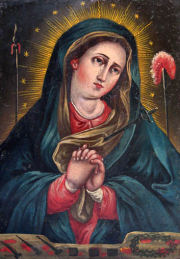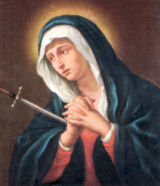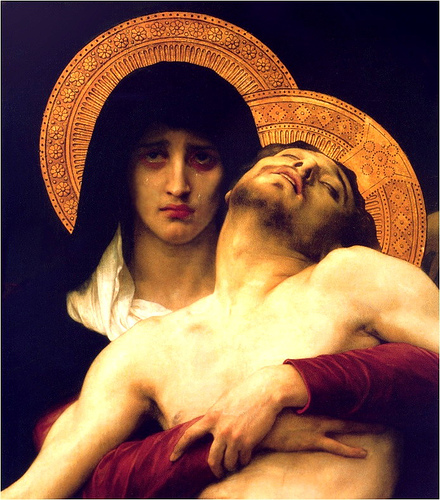“Exaltabo
te. Deus meus Rex” (Psalm 144)
Like
a privileged man fresh from the experience
of
being elevated, concentrated, purged,
into
a contemplation of exceptional intensity
and
transforming purity,
Augustine
begins his sermon
with
a power to convince without effort or questioning
his
congregation:
“I
have dared to praise the Lord with you;”
he
finds in himself the urge to concentrate his spirit
in
all his hearers in the sure trust
that
his received fire will communicate itself to them.
So
experiencing in the act of communicating it
he
offers it with a safeguard:
“and
since [the Lord] deigns to concede this
so
that the praise which we are going to offer him
might
have an ordering
lest
there be something offensive to the one who praises,
it
is better that we seek a way of praising
from
the Scriptures of God
so
that we do not stray from the path
to
the right or left.
For
I have the boldness to say to your collective charity,
so
that God may be appropriately praised by man
God
himself praised himself,
and
because he could well praise himself,
man
therefore learned how he could praise him.”
This
passage I learned from the opening of an Apostolic Constitution
of
Pope Saint Pius X.
The
quotation was among others equally authoritative, offering encouragement,
from
the beginning of his Apostolic Constitution, Divino Afflatu, of 1911.
This
was the true divine wisdom of the Pope acknowledged in his Collect.
It
raises him from the secular encirclement of the Vatican
left
by Garibaldi and Cavour.
from
the disappointment of others at his election Conclave,
from
the tiresomeness of irrelevant “modernism”
which
time's progress soon ages
with
its pressure of pastness,
from
the march to Europe's brutal “civil war” of three years later.
A
part of a group of gestures to give the Church a higher and purer worship
aligned
with the profundity and reach of the Fathers
and
later theologians.
A
gesture of profound defiance aimed at the Godlessness
of
the revolution begun in France
ending
in the tyranny of Napoleon,
backed
up by deceptive, never universally defined reason:
too
prone to use the argument of bloodshed charged with envy.
These
words can be applied at two depth-levels.
The
first insight, deep-rooted in Christian culture, of the union in the Triune God
of
the total and equal praise of
equal
totally self-communicating Persons
offered
to and from each,
timelessly,
spacelessly,
beyond
space-time,
where
no relational opposition reigns.
An
eternal lynch-pin where creation's all is
contained
by a timeless, spaceless
self-balance
of totality in a unity-totality
as
one in se,
if
distinguishable within this unity-totality
by
Personal proceedings, yet all-containing and self-containing in identity;
participated
by the angelic spirits as invisible and powerful,
as
also by material's lower status, its equivalence with electro-magnetic energy
established
a hundred years ago,
before
atomic and sub-atomic force-bearers were located and identified.
In
this space-time worship persists, when man can embrace the appearance
of
configurations of matter-energy,
what
his spirit demands – its guarantee of order, no matter what the depth.
His
presence to self-praise and in self-praise of God
cannot
be rejected by an act of human will;
it
retains the cosmic all in a totality of changing equilibrium.
Essential
stability and serial instances:
the
former measured by self-authenticating theophany:
Nature's
highest because divine which shows itself in worship-cultus as realest,
prompting the human mind to rise in humility and always to return.
Self-knowing
is not high enough, nor tight enough to satisfy the capacity of man.
Self-praise
in the divine alone is great enough and pure enough.
Not
the all.
But
what contains the all –
as
one great timelessness and spacelessness.
Why
do we resist what's most natural?
Stykkishólmur
21 August 2012


 God vouchsafed to select the very things about Him which are most incommunicable, and in a most mysteriously real way communicate them to her. See how He had already mixed her up with the eternal designs of creation, making her almost a partial cause and partial model of it. Our Lady's co-operation in the redemption of the world gives us a fresh view of her magnificence. Neither the Immaculate Conception nor the Assumption will give us a higher idea of Mary's exaltation than the title of co-redemptress. Her sorrows were not necessary for the redemption of the world, but in the counsels of God they were inseparable from it. They belong to the integrity of the divine plan. Are not Mary's mysteries Jesus' mysteries, and His mysteries hers? The truth appears to be that all the mysteries of Jesus and Mary were in God's design as one mystery. Jesus Himself was Mary's sorrow, seven times repeated, aggravated sevenfold. During the hours of the Passion, the offering of Jesus and the offering of Mary were tied in one. They kept pace together; they were made of the same materials; they were perfumed with kindred fragrance; they were lighted with the same fire; they were offered with kindred dispositions. The two things were one simultaneous oblation, interwoven each moment through the thickly crowded mysteries of that dread time, unto the eternal Father, out of two sinless hearts, that were the hearts of Son and Mother, for the sins of a guilty world which fell on them contrary to their merits, but according to their own free will.
God vouchsafed to select the very things about Him which are most incommunicable, and in a most mysteriously real way communicate them to her. See how He had already mixed her up with the eternal designs of creation, making her almost a partial cause and partial model of it. Our Lady's co-operation in the redemption of the world gives us a fresh view of her magnificence. Neither the Immaculate Conception nor the Assumption will give us a higher idea of Mary's exaltation than the title of co-redemptress. Her sorrows were not necessary for the redemption of the world, but in the counsels of God they were inseparable from it. They belong to the integrity of the divine plan. Are not Mary's mysteries Jesus' mysteries, and His mysteries hers? The truth appears to be that all the mysteries of Jesus and Mary were in God's design as one mystery. Jesus Himself was Mary's sorrow, seven times repeated, aggravated sevenfold. During the hours of the Passion, the offering of Jesus and the offering of Mary were tied in one. They kept pace together; they were made of the same materials; they were perfumed with kindred fragrance; they were lighted with the same fire; they were offered with kindred dispositions. The two things were one simultaneous oblation, interwoven each moment through the thickly crowded mysteries of that dread time, unto the eternal Father, out of two sinless hearts, that were the hearts of Son and Mother, for the sins of a guilty world which fell on them contrary to their merits, but according to their own free will.


 1. When the time came for their purification according to the law of Moses, they brought him up to Jerusalem to present him to the Lord
1. When the time came for their purification according to the law of Moses, they brought him up to Jerusalem to present him to the Lord 1. When the Magi had departed, behold, an angel of the Lord appeared to Joseph in a dream
1. When the Magi had departed, behold, an angel of the Lord appeared to Joseph in a dream 1. Now his parents went to Jerusalem every year at the feast of the Passover. And when he was twelve years old, they went up according to custom;
1. Now his parents went to Jerusalem every year at the feast of the Passover. And when he was twelve years old, they went up according to custom; 1. So they took Jesus, and he went out, bearing his own cross.
1. So they took Jesus, and he went out, bearing his own cross. 1. And they brought him to the place called Gol'gotha (which means the place of a skull).
1. And they brought him to the place called Gol'gotha (which means the place of a skull). 1. In order to prevent the bodies from remaining on the cross on the sabbath, the Jews asked Pilate that their legs might be broken, and that they might be taken away.
1. In order to prevent the bodies from remaining on the cross on the sabbath, the Jews asked Pilate that their legs might be broken, and that they might be taken away. 1. Joseph took the body, and wrapped it in a clean linen shroud,
1. Joseph took the body, and wrapped it in a clean linen shroud,








